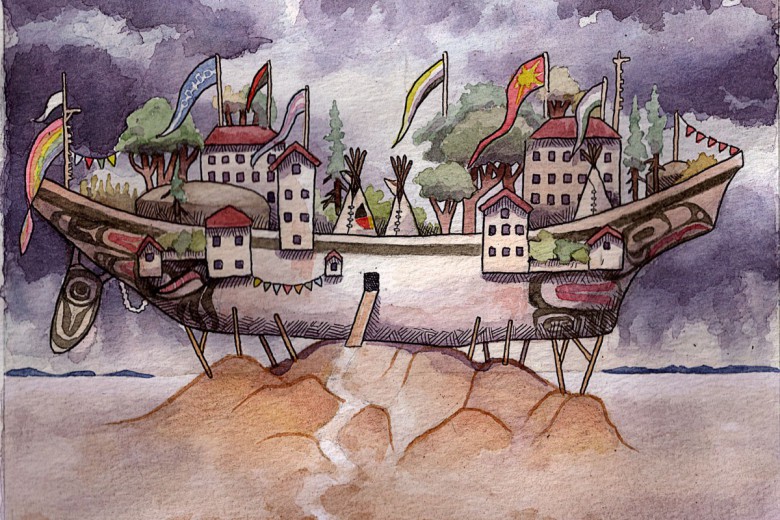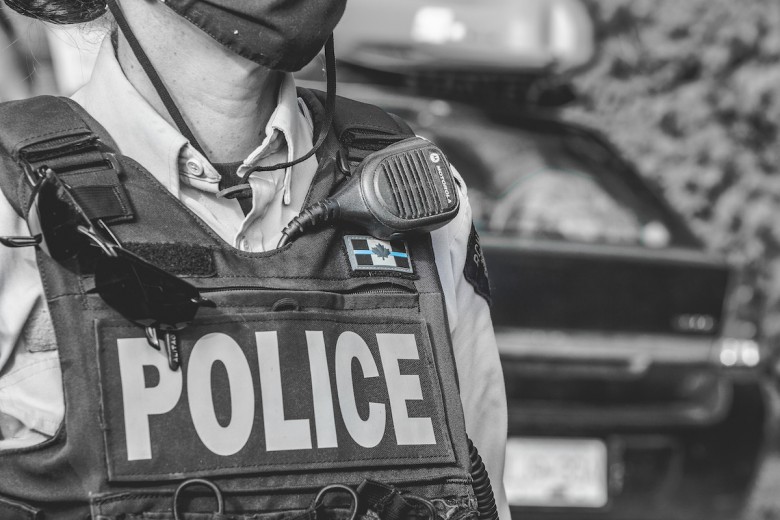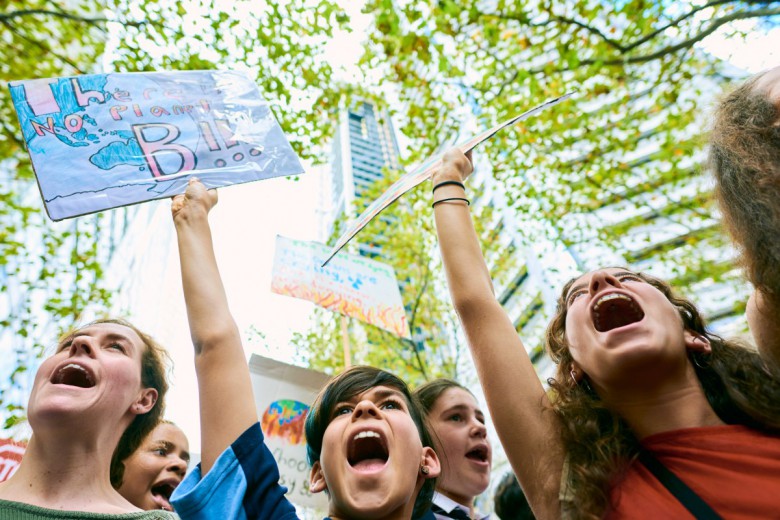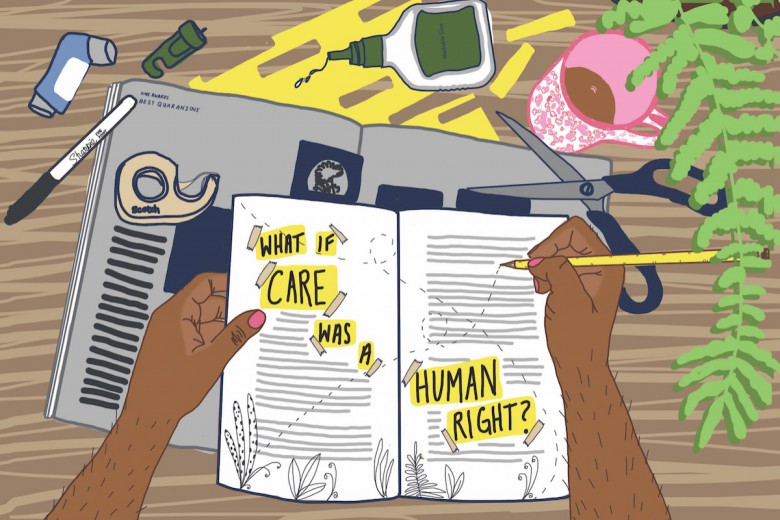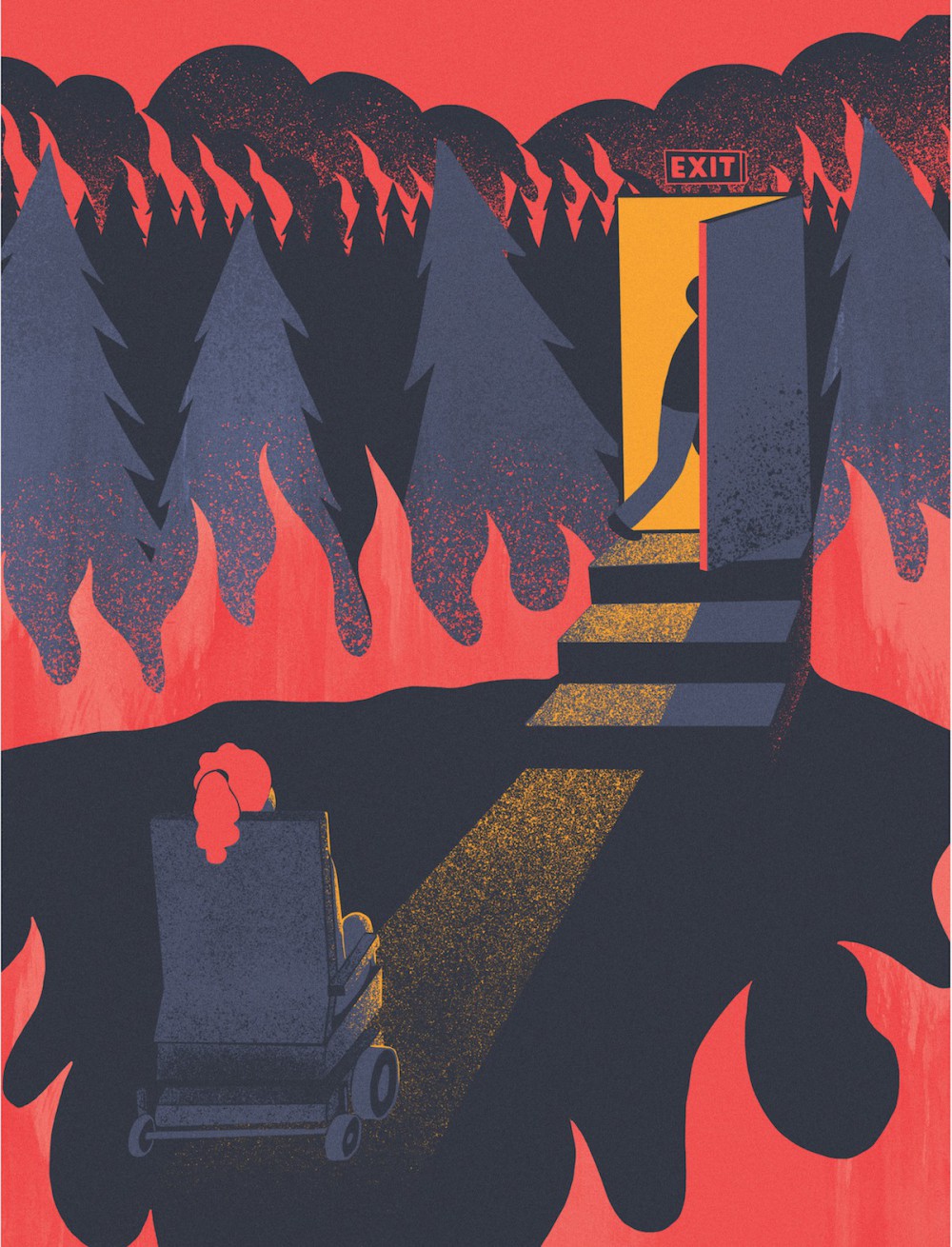
Robin Richardson-Dupuis
Lisa Johansen had, for years, structured her life around rituals of readiness. A go-bag was never far from the front door – a habit she picked up while living on an acreage in the fire-prone Okanagan. For her disabled daughter, for whom she is the full-time caregiver, Johansen stockpiled medical supplies, ordering the maximum available each month so that they would never be without.
It wasn’t enough.
In the final days of British Columbia’s 2021 heat dome, the abundant energy produced by the high-pressure system sparked 710,117 lightning bolts in less than 15 hours. It was Wednesday, June 30. The B.C. Wildfire Service’s interactive map became a densely knitted constellation of new incidents.
Johansen lives in Tumbler Ridge, B.C. It is a northern coal town surrounded by craggy mountains and endless trees. In 2021, one fire turned to three, and then six. The closest fire was just 22 kilometres from town.
“That distance feels so abstract,” Johansen said. “It just didn’t seem like a big deal.”
For a few weeks, the fires surrounding town slowly grew, but the smoke, Johansen said, wasn’t really a bother – the high winds seemed to refresh the air each afternoon.
Until, one July afternoon, Johansen looked out her window. The sky had had robin’s egg clarity all morning. Suddenly, it had blushed like a peach. The winds had changed. The fire was here.
—
Last year was, for many in B.C., the year that climate change whiplashed into the present tense. It is here. It is disproportionately killing disabled people.
For years, research has shown that in emergency contexts, disabled people are significantly more likely to suffer morbidity and mortality. During the heat dome, for example, people with schizophrenia were four times more likely to die.
It is, in part, a lack of anticipation. When the heat dome came, there was no plan to distribute air conditioning units to people whose medical conditions make them heat-sensitive; there was no plan to transport those with mobility limitations to cooling centres, nor any teams deployed to bring batteries or back-up generators to the homes of those whose power was cut.
Later in the year, there was no plan to fly in life-sustaining medical care when the floods caused a months-long interruption to transportation networks. Highways in the province were in shambles, rendering rural dialysis patients unable to make it to their appointments. People who need specialized diets to keep medical symptoms at bay (like one family I spoke with, whose child’s seizures only stop when they can maintain a ketogenic diet) came nightmarishly close to running out of ingredients when their grocery’s shelves were left empty for weeks. In Tumbler Ridge, Johansen couldn’t order her daughter’s food products for more than two months.
During the heat dome, for example, people with schizophrenia were four times more likely to die.
During the heat dome, the Vancouver Sun reported that “thousands of people sought medical help for heat stroke, dehydration and even brain injury caused by heat, but there’s no way to track that in B.C.,” according to Dr. Melissa Lem, president-elect of the Canadian Association of Physicians for the Environment. And at least 500 people died from extreme weather in B.C. in 2021. They were all preventable deaths.
“And when we say that, we need to assign blame,” says Gabrielle Peters, a disabled advocate and policy analyst who lives in Vancouver.
“These deaths are preventable? Well, who didn’t prevent it? What wasn’t done?”
Reports after each disaster remind citizens of what the government did: the cooling centres it opened, the evacuation centres it staffed.
“I’m so tired of [the government] listing what they did do,” says Peters. “I don’t care about the few steps you took. They didn’t work.”
—
It is not a question of if an extreme weather event wreaks havoc, but when. Across B.C., extreme summer temperatures (which facilitate the start and the spread of forest fires) have already become 20 times more likely. Vegetation crisps, waiting to explode from a single spark. Johansen’s beloved winds become stronger and can push fires farther, faster. Lightning strikes more often, too: for every degree of warming, lightning activity is expected to rise by 12 per cent.
In Tumbler Ridge, this wasn’t the first evacuation. When a wildfire threatened the town 16 years ago, the fire department went door to door. Residents had half an hour.
“These deaths are preventable? Well, who didn’t prevent it? What wasn’t done?”
“Half an hour is nothing,” Johansen said. The wheelchair adaptations in her van use a four-point attachment system, operated by a pulley.
Thirty minutes is not a gracious window – it is a sprint. It is a prayer that nothing goes wrong and that the cat isn’t hidden in some far corner under the couch. It means that the van is left fully packed for evacuation and then stays that way for four months.
Some disability activists have advocated for graduated alerts. In such systems, emergency notifications like mandatory evacuation alerts are triggered earlier for some community members. A wheelchair user might be notified hours or even days before a fire is truly emergent. These have not been widely adopted. For now, all Johansen has is herself.
—
In April 2022, the B.C. coroner convened a death review panel to investigate excessive mortality during the heat dome. Several prominent disability advocates were invited – but, as Peters, who was on the panel, told me, they weren’t actually invited to speak.
The subsequent report, released June 7, found that 80 per cent of the 619 people in B.C. who died had three or more chronic, underlying health conditions. Still, Peters told Capital Daily that her name was removed from the final report after her recommendations were rejected. There are no plans to distribute cooling units this summer. There is also no information about the accessibility of cooling shelters – how vulnerable individuals would be transported to them, whether they would be open 24/7, or how the risk of COVID-19 would be minimized in these shared indoor spaces.
It is unlikely that a meaningful report into the increased risk for disabled residents could even be made: B.C. does not disaggregate data about disability. When disabled people are killed disproportionately, unnecessarily, and preventably – as they are by the pandemic, by the heat, by the toxic wildfire smoke – they die in silence. Without the data, adequate interventions are nearly impossible.
Still, Peters told Capital Daily that her name was removed from the final report after her recommendations were rejected.
This invisibilization is echoed in policy and planning.
A 120-page summary report of a forum on extreme heat prepared for the Integrated Partnership for Regional Emergency Management in Metro Vancouver in November 2021 makes just one mention of disability. The three provincial agencies contacted for this article sent a total of 18 ongoing action items in response to a list of questions about disability and emergency management. Of the 18, only one even mentioned disability: “Emergency Management BC encourages local communities to connect with local and provincial organizations in the disabilities sector (e.g. Disability Alliance of BC) to support the disabled community.”
Sébastien Jodoin, associate professor at McGill University and founder of the Disability-Inclusive Climate Action Research Program, recently concluded a survey of climate mitigation policies from around the world. “Every country that had a publicly available policy was included,” he says. Of 212 federal-level policies from 146 countries, the total number of policies that had any meaningful mention of accessibility or disability: zero.
Climate adaptation policies fare slightly better – 40 policies reference disability. “But,” says Jodoin, “it’s almost always the case that they’re included in a list of vulnerable groups,” without a single measure taken to reduce their vulnerability. “We could not find a policy where meaningful measures were included.”
—
Gabrielle Peters was at home when the fire alarms came on last year. She rolled her wheelchair into the hall. Red and blue lights flashed through the windows. She heard sirens and the screams of her neighbours through the constant bellow of the alarm: this is not a drill. Evacuate now. Take the stairs.
“My neighbour walked out and saw me. She just started crying. I smiled and tried to be reassuring. I didn’t want another person to become trapped in the fire with me. I told her to leave.”
And then, Peters was alone. The sirens continued. The air smelled like smoke.
B.C.’s fire codes are extensive: there are laws about fire exits, not blocking fire exits, the number of exits, about fire doors and smoke detectors and sprinklers. There are regulations and enforcement and fines.
But buildings are still built in a way that will trap some residents inside.
I mentioned this scenario: when we realize more people need help than we have resources for, what’s the plan?
“We forgot to tell the public that what we mean is all those regulations apply to get non-disabled people out,” Peters says, her voice faint due to a bout with her respiratory condition. “We’ve decided it’s OK to put disabled people into housing they can’t get out of on their own if there’s a fire.”
She waited. And waited. She called the fire department to ask whether anyone was coming to evacuate her.
No one did.
Later, she would speak to department officials. They had put the fire out – “lucky,” a firefighter said, “because we barely cleared two or three floors” of the 20-storey building. “Off the record,” a firefighter told her, “you should do whatever you can to get yourself out.”
When the fire comes, no one is coming for Peters. No one is coming for the dozens of other residents who, like her, use mobility devices – if not wheelchairs, then walkers or canes.
Reporting this piece, I spoke with representatives from Prepared B.C., Emergency Management B.C., and the Ministry of Health. I mentioned this scenario: when we realize more people need help than we have resources for, what’s the plan?
There was none. Emergency Management B.C. said that in emergency scenarios, individuals should check on their loved ones “who are unable to leave their homes.” They suggested that “evacuees or potential evacuees should contact their local government or First Nation Emergency Operations Centre for evacuation support. The Province will support local governments in these evacuations as necessary.”
“There was some confusion last year, like, who’s responsible for this?” says Dr. Jennifer Baumbusch. Baumbusch is a registered nurse and associate professor at UBC who researches disability. So far, no one has been held accountable. Of the 18 action items sent by agencies, five delegate responsibility to other agencies and institutions; three downloaded responsibility onto individuals, and four intended to create better messaging campaigns to inform citizens of those responsibilities.
“We know there’s going to be a next time,” Baumbusch tells me. “We also know help from the government isn’t going to happen fast enough. Families need to come up with a plan.”
“They sent me a pamphlet [during the heat dome]. It just had a list of things that I should buy,” Peters says. They were all items that were too expensive for her to afford.
In Canada, disabled people live in manufactured poverty. The Canada Pension Plan disability benefit keeps people who are unable to work due to their disability well below the poverty line, tiptoeing around destitution. They are true-poor, “for the rest of my life, I’m never going to get a haircut” poor, says Peters. “I’m never going to go to a movie. I’m never going to go for dinner with my friends.”
In the context of rapidly amplifying local climate impacts, this also means limited purchasing power for in-home climate adaptations – virtually none of which are subsidized by B.C.’s medical plan, even though many such items would substantially reduce the symptoms some disabled people experience during extreme weather. There are no HEPA filters for those with respiratory conditions when the smoke blows in. There are no window AC units for those with heat sensitivities. There are no second batteries for those on oxygen machines who might get stuck in snails’-paced traffic should their town need to evacuate, all at once, and on short notice.
Until robust, preventative plans and accommodations are implemented, disabled folks will continue to do what they have always done: navigate the unnecessary and artificial burdens that structural ableism imposes on them with a nimbleness and a creativity that is unmatched in any governmental responses brought forth in 2021.
“We know there’s going to be a next time,” Baumbusch tells me. “We also know help from the government isn’t going to happen fast enough. Families need to come up with a plan.”
And planning they are. When I speak to Johansen on the phone, it is April. I am in Victoria; she is at home in Tumbler Ridge. We had both woken up to snow. We make small talk about being ready for spring.
Johansen sighs when I mention our hemisphere’s arc toward warmer weather. She’s still tired from what last summer did to her.
When the skies first turned red with fire, Johansen’s stomach had dropped, but something clicked in her mind: she wasn’t ready for this. Since becoming her daughter’s full-time medical caregiver, Johansen had learned to be a paragon of preparedness. It was a survival instinct. Suddenly, though, that scaffolding seemed to collapse.
They wouldn’t end up needing to evacuate that day – or indeed, any time that summer. But given the degree to which Johansen’s life felt suspended, she almost wonders if it would have been easier if they had. For months, wildfire had been her world’s magnetic centre.
Each day she stuck new Post-it Notes on the locations of the nearby fires, noting each fire’s spread.
A go-bag would no longer cut it. They needed a ready-to-go van. It took Johansen days to understand the best way to pack. She had to learn where in the van it would stay cool enough to store her daughter’s meal equipment – she is tube-fed, and her food products require refrigeration. Another heat wave was baking B.C. Finally, Johansen found a hollow cavern above the wheel well, where she Tetrised in the huge parcels full of food, folded in with other back-up medical equipment.
Even after she had worn through the infinite variations of how best to pack their van, Johansen’s morning routines were hijacked: cool morning walks and slow coffees were replaced by a frantic refreshing of the fire maps and weather forecasts. Each day she stuck new Post-it Notes on the locations of the nearby fires, noting each fire’s spread.
It wasn’t enough to keep her worry at bay. She resolved to do better. Through the winter, she kept scheming better ways to pack, to increase storage, to better manage the van’s internal temperature so it could store medical equipment without compromising heat-sensitive gear.
“This year,” Johansen says, “I’m basically ramping up already.” Looking out her window at the lingering snow, Johansen sighs into the phone. “I’m already planning.”
—
It feels impossible to remember now that the heat dome, and the fires it ignited, weren’t even the province’s first extreme weather event of 2021. Summer came after a vicious cold snap in February, followed by an unusually arid spring. But as sidewalks buckled and millions of sea creatures were boiled alive, this extreme heat event seemed to act as an undeniable punctuation mark. A threshold had been crossed.
The weather stayed unrelentingly hot. The heat created a record-breaking drought, crisping the vegetation in advance of the fires. The inferno only ended when a bomb cyclone and then a record number of atmospheric rivers drenched the coast. It rained, and rained, and rained.
“I’m so tired of [the government] listing what they did do,” says Peters. “I don’t care about the few steps you took. They didn’t work.”
November brought floods. It brought the closure of nearly every throughway in and out of the lower mainland. It rained so hard, and for so long, that kilometres-long swirls of dirt and debris that bloomed into the Pacific at the Fraser River’s estuary were visible from space.
What the year failed to bring: a systematic review of how these weather events are disproportionately killing disabled people in British Columbia. They had each died a preventable death.
“None of the things we’re doing” in response to these catastrophes, Peters says, “come from a real commitment to prioritizing human life.”
Update, June 30: This article misattributed the following quote – "for the rest of my life, I’m never going to get a haircut. [...] I’m never going to go to a movie. I’m never going to go for dinner with my friends” – to an anonymous source. In fact, the source was Gabrielle Peters. The article has been updated to correct the error.


